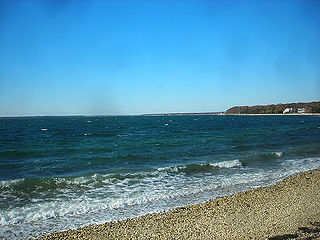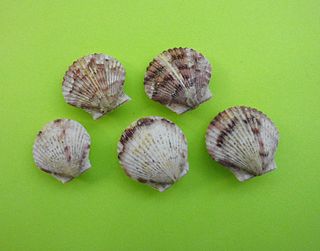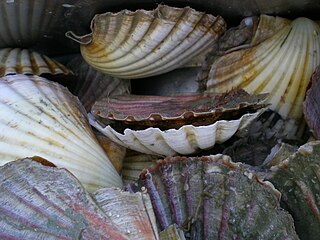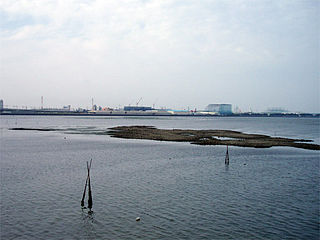Related Research Articles

Oyster is the common name for a number of different families of salt-water bivalve molluscs that live in marine or brackish habitats. In some species, the valves are highly calcified, and many are somewhat irregular in shape. Many, but not all oysters, are in the superfamily Ostreoidea.

Long Island Sound is a marine sound and tidal estuary of the Atlantic Ocean. It lies predominantly between the U.S. state of Connecticut to the north and Long Island in New York to the south. From west to east, the sound stretches 110 mi (180 km) from the East River and the Throgs Neck Bridge in New York City, along the North Shore of Long Island, to Block Island Sound. A mix of freshwater from tributaries, and saltwater from the Atlantic Ocean, Long Island Sound is 21 mi (34 km) at its widest point and varies in depth from 65 to 230 feet.

Gardiners Bay is a small arm of the Atlantic Ocean, approximately 10 mi (16 km) long and 8 mi (13 km) wide in the U.S. state of New York between the two flukelike peninsulas at the eastern end of Long Island. It is bounded on its eastern end, where it connects to Block Island Sound, by Gardiners Island and Promised Land.

The Peconic Bay is the parent name for two bays between the North Fork and South Fork of Long Island in Suffolk County, New York, United States. It is separated from Gardiners Bay by Shelter Island.

A fish hatchery is a place for artificial breeding, hatching, and rearing through the early life stages of animals—finfish and shellfish in particular. Hatcheries produce larval and juvenile fish, shellfish, and crustaceans, primarily to support the aquaculture industry where they are transferred to on-growing systems, such as fish farms, to reach harvest size. Some species that are commonly raised in hatcheries include Pacific oysters, shrimp, Indian prawns, salmon, tilapia and scallops.
Oyster farming is an aquaculture practice in which oysters are bred and raised mainly for their pearls, shells and inner organ tissue, which is eaten. Oyster farming was practiced by the ancient Romans as early as the 1st century BC on the Italian peninsula and later in Britain for export to Rome. The French oyster industry has relied on aquacultured oysters since the late 18th century.

Yaquina Bay is a coastal estuarine community found in Newport, Oregon. Yaquina Bay is a semi-enclosed body of water, approximately 8 km2 (3.2 mi2) in area, with free connection to the Pacific Ocean, but also diluted with freshwater from the Yaquina River land drainage. The Bay is traversed by the Yaquina Bay Bridge.

Argopecten gibbus, the Atlantic calico scallop, is a species of medium-sized edible marine bivalve mollusk in the family Pectinidae, the scallops.

Pecten novaezelandiae, common name the New Zealand scallop, is a bivalve mollusc of the family Pectinidae, the scallops. Its name is sometimes found misspelt as Pecten novaezealandiae.

Netarts Bay is an estuarine bay on the northern Oregon Coast of the U.S. state of Oregon, located about 5 miles (8.0 km) southwest of Tillamook. The unincorporated community of Netarts is located on the north end of the bay and Netarts Bay Shellfish Preserve, managed by Oregon Department of Fish and Wildlife, is located on the south side of the bay. The sand spit on the west side of Netarts bay is part of Cape Lookout State Park.

Patchogue Bay is a lagoon on the south-central shores of Long Island in the U.S. state of New York.

As with other countries, the 200 nautical miles (370 km) exclusive economic zone (EEZ) off the coast of the United States gives its fishing industry special fishing rights. It covers 11.4 million square kilometres, which is the second largest zone in the world, exceeding the land area of the United States.

Michael Alan Rice, is an American professor of fisheries and aquaculture at the University of Rhode Island and former state representative from South Kingstown, Rhode Island. A Democrat, he served in the Rhode Island House of Representatives, representing the 35th district, encompassing the village of Kingston and West Kingston, and parts of the neighborhoods of Tuckertown, Wakefield and Peace Dale. Rice was first elected on November 4, 2008, and served from January 3, 2009, to January 3, 2011.

Aquaculture started to take off in New Zealand in the 1980s. It is dominated by mussels, oysters and salmon. In 2007, aquaculture generated about NZ$360 million in sales on an area of 7,700 hectares. $240 million was earned in exports.
The South Shore Estuary is an estuary located along the south shore of Long Island, between the mainland and the outer barrier islands, in eastern New York state. It stretches for over 70 miles (110 km) from West Bay in Nassau County to the Shinnecock Bay in Suffolk County.

Scallop aquaculture is the commercial activity of cultivating (farming) scallops until they reach a marketable size and can be sold as a consumer product. Wild juvenile scallops, or spat, were collected for growing in Japan as early as 1934. The first attempts to fully cultivate scallops in farm environments were not recorded until the 1950s and 1960s. Traditionally, fishing for wild scallops has been the preferred practice, since farming can be expensive. However worldwide declines in wild scallop populations have resulted in the growth of aquaculture. Globally the scallop aquaculture industry is now well established, with a reported annual production totalling over 1,200,000 metric tonnes from about 12 species. China and Japan account for about 90% of the reported production.

Oyster reef restoration refers to the reparation and reconstruction of degraded oyster reefs. Environmental changes, modern fishing practices, over harvesting, water pollution, and other factors, have resulted in damage, disease, and ultimately, a large decline in global population and prevalence of oyster habitats. Aside from ecological importance, oyster farming is an important industry in many regions around the world. Both natural and artificial materials have been used in efforts to increase population and regenerate reefs.

Zostera marina is a flowering vascular plant species as one of many kinds of seagrass, with this species known primarily by the English name of eelgrass with seawrack much less used, and refers to the plant after breaking loose from the submerged wetland soil, and drifting free with ocean current and waves to a coast seashore. It is a saline soft-sediment submerged plant native to marine environments on the coastlines of northern latitudes from subtropical to subpolar regions of North America and Eurasia.

The Maria Mitchell Association Aquarium, also known as the Nantucket Aquarium, is a small, local, seasonal aquarium in Nantucket, Massachusetts. It serves as the island's only marine science center and resource. The Aquarium is one of the many resources offered by the Maria Mitchell Association, a local non-profit organization that promotes scientific education and research in service to the legacy of Maria Mitchell (1818-1889), America's first female astronomer and Nantucket native.
Laxey Bay is a coastal feature and Marine Nature Reserve on the east coast of the Isle of Man in the north Irish Sea. Geographically it is bounded by Laxey Head to the north and Clay Head to the south.
References
- ↑ Tettelbach, St; Peterson, Bj; Carroll, Jm; Furman, Bt; Hughes, Swt; Havelin, J; Europe, Jr; Bonal, Dm; Weinstock, Aj; Smith, Cf (2015-06-08). "Aspiring to an altered stable state: rebuilding of bay scallop populations and fisheries following intensive restoration". Marine Ecology Progress Series. 529: 121–136. Bibcode:2015MEPS..529..121T. doi:10.3354/meps11263. ISSN 0171-8630.
- ↑ "Peconic Bay Scallop - Arca del Gusto". Slow Food Foundation. Retrieved 2024-01-17.
- 1 2 MacGregor, Jessica (May 2023). Stressed-Out Scallops: Analyzing Drivers of Physiological Stress and Mortality of the Northern Bay Scallop (Argopecten irradians irradians) in the Peconic Estuary, NY (Thesis). State University of New York at Stony Brook. ProQuest 2820011499 . Retrieved 16 January 2024.
- 1 2 3 4 "Restoring the Peconic Bay Scallop – Peconic Estuary Partnership". www.peconicestuary.org. Retrieved 2024-04-10.
- ↑ "Nassau County Back Bays Study". www.nap.usace.army.mil. Retrieved 2024-04-10.
- 1 2 3 Robey, Charity (2018-11-25). "North Fork History Project: The scallop industry has a rich past on eastern Long Island". Riverhead News Review. Retrieved 2024-01-17.
- ↑ MacKenzie, Jr (2008). "The Bay Scallop, Argopecten irradians, Massachusetts Through North Carolina: Its Biology and the History of Its Habitats and Fisheries". Marine Fisheries Review. 70 (3–4): 5–79. ISSN 0090-1830.
- 1 2 3 Macht, Hilary (2023-03-27). "Scientists Scramble to Help Bay Scallops Survive Climate Change". Civil Eats. Retrieved 2024-01-17.
- 1 2 3 Harrington, Mark (2023-11-29). "Ailing Peconic Bay scallops could get help from Moriches Bay upsurge". Newsday. Retrieved 2024-02-27.
- 1 2 Bernstein, James (2024-04-17). "Selective Breeding Aims to End Peconic Bay Scallop Scarcity". www.danspapers.com. Retrieved 2024-04-26.
- ↑ "The Seeds Of A Possible Restoration For Long Island's Cherished Peconic Bay Scallops". WLIW. 9 February 2024. Retrieved 27 February 2024.
- ↑ Harrington, Mark (2024-02-09). "Moriches Bay scallops offer hope for a restoration of the Peconic". Newsday. Retrieved 2024-02-27.